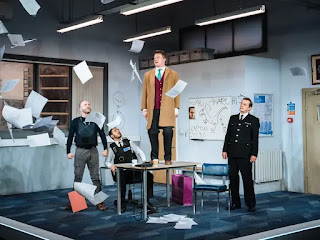Anarchists and Art
Accidental Death of an Anarchist
An angry satire within a breakneck speed farce, at the interval I felt a bit like I had been battered to submission by words and a restorative ice cream was definitely required. The play opens with 'The Maniac' (Daniel Rigby) protesting his innocence to a policeman (Mark Hadfield) due to insanity and brandishes his certificate to prove it. The hour and fifty minutes is a whirlwind tearing through the state of justice, passing with barely a glance at some awful statistics. There are references to police brutality and well known cases of incompetence, coverup and downright criminality from Stephen Lawrence, via undercover officers to Sarah Everard, not forgetting the Public Order Bill, dodgy Home Secretaries and appalling dismissal and conviction rates for police misconduct. So far so good. And I loved that the music in the interval included Police and Thieves and other songs about misbehaving police.The script, written by Tom Basden (based on the Italian play by Dario Fo and Franca Rame) is smart and funny and the farce elements are delivered beautifully. In the first half in particular though, the pace was so fast that it became a bit one note. The facts and figures about police conduct and injustice are delivered at the same pace and are almost lost in the unrelenting speed of the whole performance. The second half slows down a touch, opening with a good minute or two of pure physical comedy, and with a new character, bringing a bit more variety in pace and tone. That does mean that some of the facts land a bit harder, and the shutting down of the laughter at the line ‘I can’t breathe’ and applause at various points when the fourth wall was regularly broken to deliver some more cold doses of facts (and sometimes sweeties) is more evidence that the audience was listening. Possibly the bit that landed the hardest though was the display as the actors left the stage, counting up the 1,861 deaths in police custody in England and Wales since 1990, when it all went a bit quiet quite quickly.
So, this is a good and valuable work then? Well sort of. I’ve already mentioned the pace which skimmed past so fast that the facts were often not even given a nod amongst the jokes before moving on. It could be argued that the cursory treatment is apt in showing how much attention anyone pays to this stuff but I’m not totally convinced. Secondly, and probably more importantly, as pointed out in the play, and referenced in the programme, it’s easy to do the right wokerati type thing, sign petitions, applaud at political plays, and grumble but where is the action that will come from that? I gather the original Italian version based on a real case did lead to real life demonstrations but that isn’t going to happen here I fear. But it’s still worth seeing the play, which is great fun regardless, and then go home and at least have a think about some direct action a bit stronger than a twitter grumble.
A mini pilgrimage amongst the crowds
The thing about the National Gallery is that every room is full of masterpieces as well as crowds so it becomes a bit overwhelming, and as I wandered from room to room I found I got a bit more picky. In particular, I still don’t get why Stubbs horse paintings are so great - clearly I am missing something.
* After writing this I found an analysis on Tumblr of the importance of the Caravaggio piece to Elle (because of course someone else is as invested as I am in seemingly small details) and it makes a lot of sense https://thedecadenceofwar.tumblr.com/post/724743102415421440/safe-space-by-elle-argent-sheher


.jpg)
Comments
Post a Comment